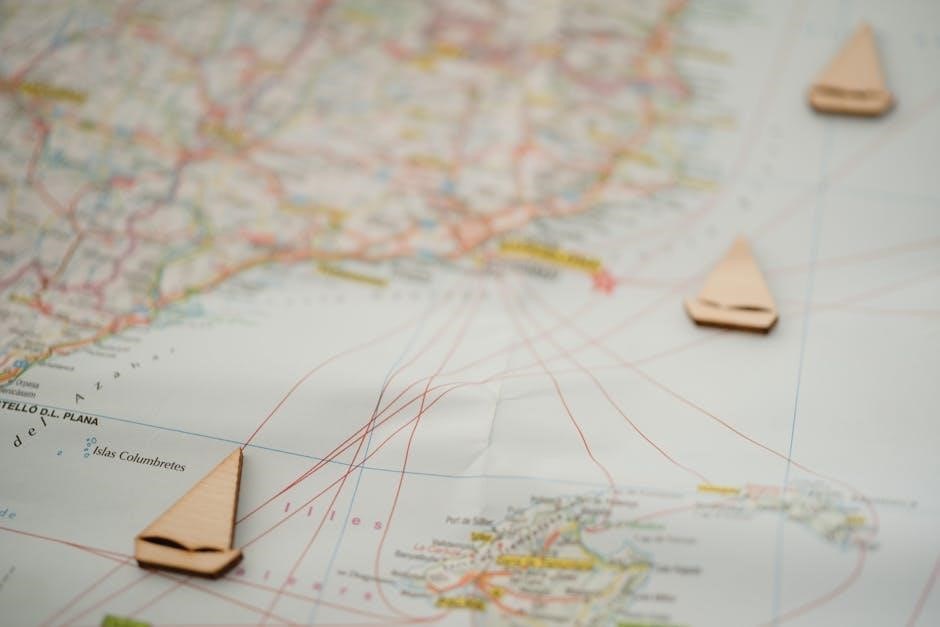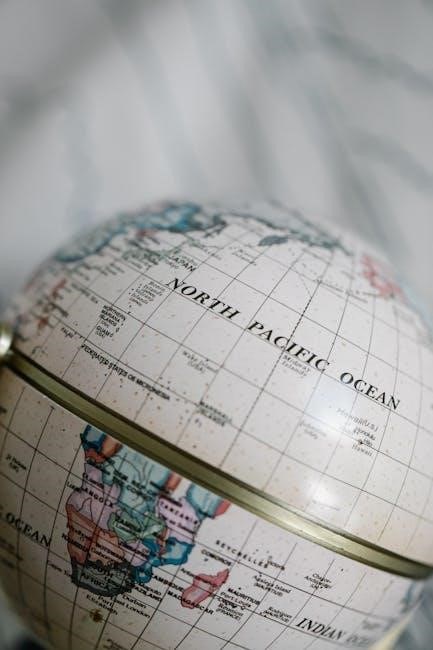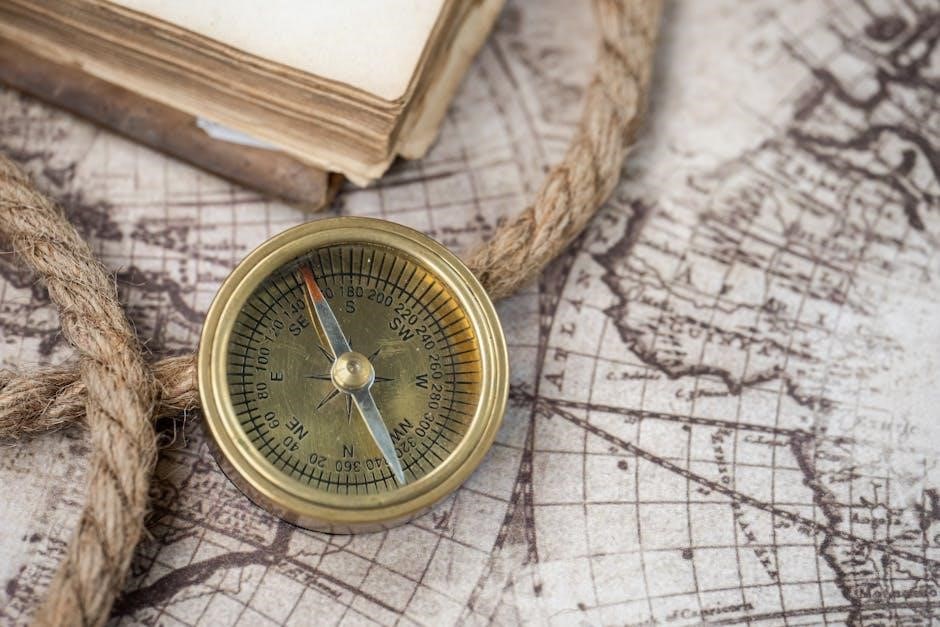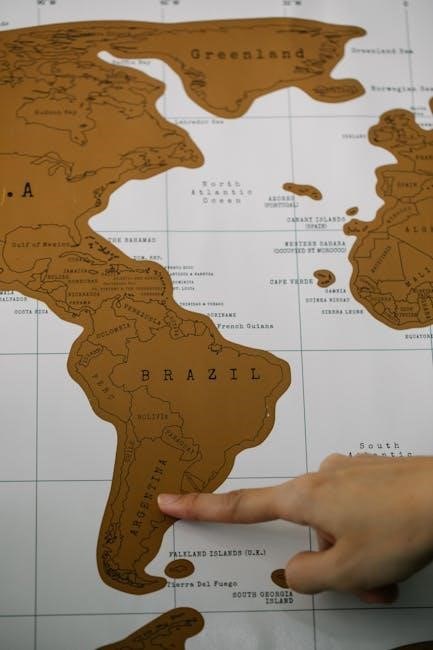World maps with longitude and latitude are essential for geography, providing a systematic way to locate positions globally. They are widely used in education, navigation, and available as printable PDFs.
1.1 Overview of the Importance of Longitude and Latitude
Longitude and latitude are fundamental for identifying precise locations on Earth. They form a grid system essential for navigation, meteorology, and climate studies. These lines enable accurate mapping, aiding in travel planning and educational purposes. Printable PDFs of world maps with these grids are widely used for geographical studies and projects. The Equator and Prime Meridian serve as primary references, dividing the globe into hemispheres. Understanding these coordinates enhances global communication and scientific research, making them indispensable tools in various fields. Their importance lies in their ability to pinpoint locations, facilitating everything from weather forecasting to international travel. Thus, they remain vital for modern cartography and global understanding.
1.2 Brief History of Latitude and Longitude in Cartography
The concept of latitude and longitude dates back to ancient Greek philosophers, with Hipparchus and Ptolemy advancing their use. By the Middle Ages, these lines became integral to navigation. The invention of the printing press spread their use, making world maps more accurate. The Mercator projection, developed in the 16th century, further popularized their application. Today, printable PDFs of world maps with latitude and longitude grids are freely available, aiding education and projects. Their historical evolution reflects humanity’s quest to understand Earth’s geography, making them indispensable tools in modern cartography and global navigation.

Understanding Latitude and Longitude
Latitude and longitude are reference lines used to identify locations on Earth. Latitude measures north-south positions, while longitude measures east-west, creating a grid system for mapping.
2.1 Definition and Purpose of Latitude
Latitude refers to the angular distance north or south of the Earth’s equator, measured in degrees. It ranges from 0° at the equator to 90° at the poles. The purpose of latitude is to determine the north-south position of any location on the globe. It is crucial for cartography and navigation, as it helps in creating detailed maps and determining the vertical positioning of places. On a world map with longitude and latitude, parallel lines called parallels represent latitude, spaced at regular intervals; This system allows for precise location identification, enhancing the usability of maps for various applications such as education and travel planning.
2.2 Definition and Purpose of Longitude
Longitude measures the angular distance east or west of the prime meridian, ranging from 0° at Greenwich, England, to 180° east or west. It determines the east-west position of a location on Earth. Meridians of longitude converge at the poles, unlike parallels of latitude, which are parallel. The purpose of longitude is to identify how far east or west a place is, essential for navigation, time zone determination, and accurate mapping. On a world map with longitude and latitude, meridians are vertical lines, helping users pinpoint locations globally. This system, combined with latitude, enables precise coordinate identification, vital for various applications like travel planning and weather forecasting.
2.3 How Latitude and Longitude Work Together
Latitude and longitude form a grid system that enables precise location identification on Earth. Latitude determines the north-south position, while longitude specifies the east-west position. Together, they create a coordinate system where any point on the globe can be pinpointed using degrees, minutes, and seconds. This combination allows for accurate mapping, navigation, and geographical studies. On a world map with longitude and latitude, the equator (0° latitude) and prime meridian (0° longitude) serve as reference points. Their intersection at 0°,0° near Accra, Ghana, exemplifies how these lines work together to define global positions. This system is indispensable for cartography, travel planning, and scientific research, providing a universal framework for understanding Earth’s surface.

Reading a World Map with Latitude and Longitude
Understanding latitude and longitude enhances map-reading skills, enabling users to pinpoint locations, plan routes, and study global geography effectively using printable PDF resources.
3.1 Identifying Key Lines: Equator and Prime Meridian
The Equator and Prime Meridian are fundamental reference lines on world maps. The Equator, at 0° latitude, divides the Earth into the Northern and Southern Hemispheres. The Prime Meridian, at 0° longitude, separates the Eastern and Western Hemispheres and passes through Greenwich, England. These lines intersect at the center of the map, creating a grid system essential for determining coordinates. Identifying these lines is the first step in reading a world map with latitude and longitude; They provide a starting point for measuring distances and locating specific points. Printable PDF maps often highlight these lines clearly, making them easier to identify for educational and navigational purposes. Understanding these key lines is crucial for accurate map interpretation.
3.2 Understanding Degrees, Minutes, and Seconds
Degrees, minutes, and seconds are the units used to measure latitude and longitude. A degree is the largest unit, with 360 degrees in a full circle. Each degree is divided into 60 minutes, and each minute into 60 seconds. This system allows for precise location identification. For example, coordinates might be expressed as 40° 26′ 30″ N, 79° 56′ 15″ W. Understanding these units is essential for accurately reading world maps with latitude and longitude. Printable PDF maps often include grids and labels to help users identify these measurements. This system enhances the ability to locate specific points and plan educational or navigational projects effectively.
3.3 Locating Specific Coordinates on the Map
Locating specific coordinates on a world map with latitude and longitude requires precise grid referencing. Start by identifying the equator and prime meridian as reference points. Latitude lines run horizontally, while longitude lines run vertically. To find a location, align the given coordinates with the map’s grid. For instance, if the coordinates are 40° N latitude and 79° W longitude, trace 40 degrees north from the equator and 79 degrees west from the prime meridian. Their intersection marks the desired location. Printable PDF maps often include detailed grids to facilitate accurate plotting. This method is invaluable for educational projects, navigation, and geography studies, ensuring precise and efficient location identification worldwide.

Applications of World Maps with Latitude and Longitude
World maps with latitude and longitude are vital for education, navigation, meteorology, and climate studies. They aid in locating places, planning travel, and understanding global weather patterns.
4.1 Educational Uses in Geography and Social Studies
World maps with latitude and longitude are invaluable in education, particularly in geography and social studies. They provide students with a visual tool to understand global spatial relationships, helping to identify countries, oceans, and continents. Printable PDF versions are widely used for classroom activities, such as locating coordinates, tracing travel routes, and studying climate patterns. These maps also aid in teaching concepts like time zones, cultural distributions, and environmental issues. By incorporating latitude and longitude grids, educators can enhance lessons on cartography and spatial awareness. Additionally, such maps are useful for interactive projects, enabling students to mark historical events or explore geopolitical phenomena. This makes them an essential resource for fostering a deeper understanding of the world.
4.2 Role in Navigation and Travel Planning
World maps with latitude and longitude play a crucial role in navigation and travel planning. They provide precise location references, enabling users to determine distances, plan routes, and estimate travel times. For travelers, these maps help identify time zones and understand geographical layouts, making trip organization more efficient. Pilots, sailors, and adventurers rely on these grids to pinpoint exact coordinates, ensuring accurate navigation. Additionally, high-resolution PDF versions allow for detailed planning, especially in remote areas with limited digital resources. By offering a clear visual framework, these maps are indispensable tools for anyone needing to traverse or explore the globe effectively.
4.3 Importance in Meteorology and Climate Studies
World maps with latitude and longitude are vital in meteorology and climate studies for tracking weather patterns and understanding global climate systems. By using these grids, scientists can pinpoint storm trajectories, monitor temperature variations, and analyze precipitation trends. Longitude helps determine time zones, crucial for forecasting, while latitude aids in studying atmospheric circulation. High-resolution PDF maps enable detailed analysis of climate zones and seasonal changes. These tools are essential for creating accurate weather models and studying phenomena like El Niño or monsoon patterns. They also assist in mapping climate change impacts, making them indispensable for researchers and meteorologists worldwide.

Sources for Downloading World Maps with Latitude and Longitude in PDF

Sources for Downloading World Maps with Longitude and Latitude in PDF
Discover reliable sources offering free, high-resolution world maps with latitude and longitude in PDF formats. Ideal for education, navigation, and customizable to meet specific project requirements.
5.1 Free Printable PDF Resources
Explore a variety of free printable PDF resources offering world maps with latitude and longitude. Websites like Printablee and others provide high-quality maps ideal for education and planning. These maps feature grid lines, country borders, and key geographical details, making them perfect for locating cities, oceans, and continents. Many resources allow customization, enabling users to tailor maps for specific projects or presentations. Whether for school, travel, or professional use, these free PDFs are a valuable tool for enhancing geographical knowledge and understanding global coordinates. They are easily downloadable and printable, ensuring accessibility for everyone.
5.2 Websites Offering High-Resolution Maps
Several websites provide high-resolution world maps with latitude and longitude, ideal for detailed planning and presentations. Platforms like Printablee and others offer downloadable PDFs featuring crisp, clear grids and country borders. These maps are perfect for educational purposes, professional projects, or travel planning. High-resolution options ensure that even small details, such as city locations and geographical features, are visible. Some websites also allow customization, enabling users to focus on specific regions or add annotations. These resources are invaluable for anyone needing precise and visually appealing maps for presentations, research, or classroom activities, ensuring clarity and accuracy in every detail.
5.3 Customizable Maps for Specific Needs
Customizable world maps with latitude and longitude offer flexibility for users to tailor maps to their specific requirements. These maps allow individuals to highlight particular regions, add annotations, or adjust the scale, making them ideal for educational projects, presentations, or travel planning. Some resources provide editable templates where users can input data or emphasize certain geographical features. This adaptability is particularly useful for educators creating lesson plans or professionals needing detailed visual aids. Customizable maps ensure that users can focus on the information most relevant to their goals, enhancing both functionality and visual appeal. They are a valuable tool for anyone seeking personalized and precise geographical representations.

Tips for Using a World Map with Latitude and Longitude
Use scale bars to measure distances, identify time zones based on longitude, and leverage the grid system for precise location accuracy when working with maps.
6.1 Measuring Distances Using Scale Bars
To effectively use a world map, utilize the scale bar for distance measurement. This tool converts map distances to actual kilometers or miles, enhancing navigation and planning. Ensure accuracy by aligning the scale bar with the map’s grid system, considering projections that might affect distance calculations. Scale bars simplify determining the distance between cities or landmarks, making them invaluable for educational projects, travel planning, and geographical studies.
6.2 Identifying Time Zones Based on Longitude
Longitude plays a crucial role in determining time zones, as each zone is roughly 15 degrees apart. By understanding the relationship between longitude and time, users can identify local times globally. The prime meridian (0°) serves as the reference point for UTC, with zones east or west adjusting accordingly. Using a world map with longitude lines, one can estimate time zones by measuring degrees from the prime meridian. This method is especially useful for educational purposes, helping to visualize how time zones align with the Earth’s rotation. While not exact due to political adjustments, this approach provides a foundational understanding of global time differences. Maps with scale bars further aid in precise measurements, enhancing accuracy for planners and travelers. Time zones are vital for coordinating global activities, making longitude an essential tool in this process.
6.3 Incorporating Maps into Presentations and Projects
Incorporating world maps with longitude and latitude into presentations and projects enhances visual learning and communication. Printable PDF maps are ideal for educational settings, allowing students to mark key locations or trace routes. For presentations, high-resolution maps can be embedded to illustrate global data, such as climate patterns or economic trends. Customizable maps enable users to highlight specific regions or add annotations, making them versatile for tailored projects. Educators often use these maps to teach geography, while professionals leverage them for business or travel planning. The ability to print or share digitally makes them accessible for various audiences. Incorporating such maps ensures clarity and engages viewers effectively in understanding spatial relationships and global concepts.

Common Mistakes to Avoid When Using Latitude and Longitude Maps
Common mistakes include confusing latitude and longitude, misjudging distances without a scale, and ignoring map projections. Always verify coordinate accuracy and understand the map’s limitations.
7.1 Confusing Latitude and Longitude
One common mistake is confusing latitude and longitude. Latitude lines run horizontally, measuring distances north or south of the equator, while longitude lines run vertically, measuring east or west of the prime meridian. Many users mistakenly associate latitude with vertical measurements and longitude with horizontal ones. This confusion can lead to incorrect coordinate identification on maps. To avoid this, remember that latitude ranges from 0° at the equator to 90° at the poles, while longitude spans from 0° to 180° east or west. Always double-check the orientation of lines and their corresponding degrees when interpreting maps. This error is especially critical in navigation and precise location identification.
7.2 Misinterpreting the Scale of the Map
Misinterpreting the scale of a world map with latitude and longitude can lead to significant errors in distance calculations. The scale bar, often located at the bottom or side of the map, indicates the relationship between distances on the map and actual kilometers. Users frequently overlook the scale, assuming all maps have the same proportions. This mistake is particularly common when using downloadable PDF maps, where the scale might vary depending on the source or projection type. Always verify the scale bar before measuring distances to ensure accurate interpretations. Ignoring this step can result in misleading conclusions, especially in educational or navigational contexts where precise measurements are crucial.
7.3 Overlooking the Importance of Projection Types
Overlooking the importance of projection types is a common mistake when using world maps with latitude and longitude. Map projections, such as Mercator or WGS 84, distort the Earth’s surface to fit a flat format, affecting distance, shape, and size representations. Ignoring these differences can lead to misinterpretations, especially in navigation or planning. For instance, the Mercator projection exaggerates polar regions, while others preserve area accuracy. Users must consider the purpose of the map and choose the appropriate projection. Downloadable PDF maps often specify their projection type, but neglecting this detail can result in inaccurate conclusions. Always verify the projection to ensure reliable data interpretation and avoid geographical miscalculations. This step is crucial for both educational and practical applications of world maps with latitude and longitude.
World maps with longitude and latitude are indispensable tools for geography, navigation, and education. Their systematic grid system enhances understanding of global positions and spatial relationships effectively.
8.1 Summary of Key Points
World maps with longitude and latitude provide a systematic grid for global positioning, enhancing spatial understanding. They are crucial for geography, navigation, and education, offering precise location references. Available as printable PDFs, these maps are versatile tools for planning and presentations. Their applications span meteorology, climate studies, and travel planning, making them indispensable for various disciplines. By understanding latitude and longitude, users can accurately pinpoint locations, measure distances, and identify time zones. These maps also highlight the importance of projections and scales, ensuring accurate interpretations. Overall, they remain essential resources for both educational and practical purposes, fostering a deeper connection with global geography.
8.2 Final Thoughts on the Utility of Latitude and Longitude Maps
World maps with latitude and longitude are indispensable tools for understanding global geography. Their utility spans education, navigation, and climate studies, providing precise location references. Printable PDF versions enhance accessibility, making them ideal for educational projects and travel planning. These maps not only aid in identifying time zones but also facilitate meteorological analyses. Their systematic grid ensures accurate spatial comprehension, while customizable options cater to specific needs. By mastering latitude and longitude, users gain a deeper understanding of Earth’s layout, making these maps essential for both practical and academic purposes. Their versatility and widespread availability solidify their importance in modern cartography.

Further Reading and Resources
Explore recommended guides and articles for deeper insights into latitude and longitude maps. Utilize online tools and resources for customizable maps and educational enhancements.
9.1 Recommended Articles and Guides
For deeper understanding, explore articles like “Understanding Latitude and Longitude” and “Mapping the World: A Guide to Grid Systems.” These resources provide comprehensive insights into geographical coordinates, their historical development, and practical applications. Additionally, guides such as “Using World Maps in Education” highlight how to integrate latitude and longitude maps into lesson plans and projects. Websites like Printablee offer downloadable PDFs, while tools like the Köppen-Geiger climate mapping system expand your knowledge of global geography. These materials are ideal for educators, researchers, and enthusiasts seeking to enhance their understanding of world maps and their applications in various fields.
9.2 Additional Tools for Map Enthusiasts
For map enthusiasts, tools like the UTM grid system and WGS 84 enhance precision in mapping. The World Economic Forum’s reports on global risks and cybersecurity offer insights into how maps are used in strategic planning. Climate mapping tools, such as the Köppen-Geiger system, provide detailed insights into global climate zones. Additionally, apps like SBS News and platforms offering high-resolution PDFs enable users to stay updated on global events and download customizable maps. These resources cater to educators, researchers, and travelers, offering practical applications for map enthusiasts to explore and analyze the world’s geography and its interconnected systems.

Glossary of Terms Related to Latitude and Longitude
Latitude: Parallel lines measuring north-south position. Longitude: Meridian lines measuring east-west position. Equator: Primary latitude line. Prime Meridian: Primary longitude line. Graticule: Grid system of latitude and longitude lines.
10.1 Key Definitions for Better Understanding
Latitude: Imaginary lines parallel to the Equator, measuring degrees north (0°-90° N) or south (0°-90° S). Longitude: Meridians running from pole to pole, measuring degrees east (0°-180° E) or west (0°-180° W). Equator: The primary latitude line at 0°, dividing the Northern and Southern Hemispheres. Prime Meridian: The 0° longitude line passing through Greenwich, England, separating the Eastern and Western Hemispheres. Graticule: The network of latitude and longitude lines creating a grid system on maps. Coordinates: A point’s location expressed as latitude and longitude. Understanding these terms enhances map-reading skills and global navigation.
